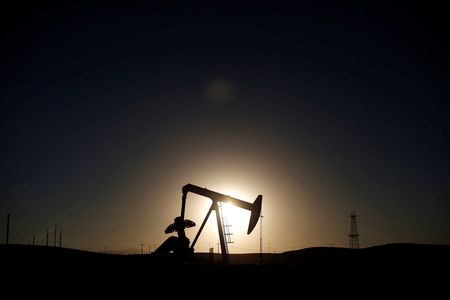Oil prices rise as global supply tightens due to lower exports from Saudi Arabia and Russia, offsetting concerns about global demand growth amid high interest rates.
Oil prices rose in Asian trade, despite a disappointing interest rate cut from China, due to the prospect of tighter supplies supporting the outlook.
China's slowing economy and worsening macroeconomic indicators may be good news for oil prices, as it could lead to changes in monetary policies and stimulate global demand for oil. Investing in oil ETFs, particularly the Energy Select SPDR Fund (XLE), which includes stable and profitable companies, may be a reliable option. There are risks involved, but with tight oil supply and central banks' desire to avoid an economic downturn, oil assets could still be favorable.
Oil prices dipped due to the possibility of Iraqi exports resuming and concerns over China's weakening economy impacting demand.
China's economic troubles could lead to lower oil prices and subsequently lower gasoline prices, providing relief for consumers and potentially impacting global energy markets.
Crude oil prices rise as US inventories decline and concerns about US rate hikes and China's economic indicators persist.
Oil prices dipped in early Asian trade due to weak manufacturing data in major economies and concerns about the duration of interest rates staying at current levels, despite a larger-than-expected drop in U.S. crude stocks.
Oil prices fell for the fourth consecutive day, with concerns about China's economic growth and potential interest rate hikes in the US weighing on the market, while the possibility of increased production from Iran and Venezuela added to bearish sentiment.
Oil prices increase as China takes steps to support its economy, but concerns about global growth, US interest rate hikes, and Chinese manufacturing data persist.
Oil prices slightly decrease as concerns over China's economic growth and potential U.S. interest rate hikes weigh on fuel demand.
Oil prices inched up on Monday as China implemented measures to support its struggling economy, although concerns about economic growth and potential US interest rate hikes continue to weigh on investor sentiment. The move by China to halve stamp duty on stock trading and the soft-landing scenario for the US economy helped boost oil prices, while the possibility of a hurricane hitting Florida could lead to short-term support for the oil price. However, the anticipation of easing sanctions on Iran and Venezuela has weakened the narrative of tightening supply.
Oil prices in Asia extended gains from the previous session due to signs of a significant decrease in US crude stockpiles and concerns about potential supply disruptions caused by Hurricane Idalia.
Markets show signs of slowing after new economic data, with focus on Friday's jobs report and the possibility of a pause on rate increases. Oil prices are impacted by Chinese factory activity and expectations of supply cuts.
The expansion in non-oil business activity in Saudi Arabia eased in August due to slower output growth and concerns over market competition, according to a business survey.
Oil prices dipped as concerns over China's slow post-pandemic recovery and weak global economic data outweighed expectations of supply cuts by OPEC+ producers.
Oil prices ease in Asia as concerns over slow demand from China outweigh fears of tighter supply due to output cuts by Saudi Arabia and Russia.
The outlook for oil prices and Chinese demand, OPEC+ supply curbs, rising flows of Iranian crude, and the transition away from fossil fuels are among the key topics discussed at Asia's largest gathering of industry traders and executives.
Oil prices jumped over 2.5% after OPEC+ members extended supply reductions, with Brent International topping $90 per barrel and West Texas Intermediate hovering above $87 per barrel, as Saudi Arabia announced an extension of its production cut and Russia reduced its exports. Despite slow recovery and increased production, crude futures have rallied more than 25% since late June, with experts predicting prices to continue rising unless a recession occurs. China's demand for petrochemicals has been dampened, but their mobility demand post-lockdowns has offset this.
The tightening of oil supply and the alliance between Saudi Arabia and Russia to push for higher prices raises concerns for consumers as fuel costs surge, potentially impacting the global economy and inflation rates.
Oil prices fell due to a stronger US dollar and concerns about Chinese economic growth, but were supported by extended supply cuts by Saudi Arabia and Russia.
Oil prices increased for a third consecutive session due to forecasts of a supply deficit in the fourth quarter, the extension of output cuts by Saudi Arabia and Russia, and optimism about a recovery in demand in China.
China's record crude oil processing and robust imports in August have painted a bullish picture of demand, but the vast quantities of oil flowing into inventories should not be ignored, with China adding about 1.32 million barrels per day to either commercial or strategic crude stockpiles in August.
Global stocks eased as a drop in U.S. homebuilding highlighted the challenges the Federal Reserve faces in managing inflation, while oil prices rose and investors await rate decisions from major central banks.
